


 |
 |
 |
| home | about | pictures | reference | trade | links |
|
||||||||||||||||||||||||||||||||||||||||||||||||||||||||||||||||||||||||||||||||||||||||||||||||||||||||||||||||||||||||||||||||||||||||||||||||||||||
| Date | Space Craft |
CPU | Note: |
| 1972 | Pioneer 10 and 11 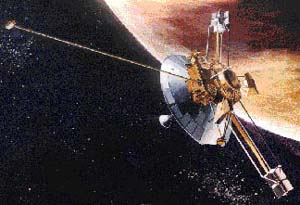 |
Custom CPU in TTL/Discrete | Early on CPU's were implemented by many chips, basically building the gates of a CPU with a custom instruction set This was very reliable but weighed a lot. |
| 1976 | Viking  |
the computer on the Viking Orbiter were General Electric 18-bit TTL machines (not 12-bit) with a bit-serial, single register accumulator and bit-serial access to plated-wire RAM (4096 words). It executed around 25,000 instructions per second. The Viking Lander computers (Honeywell HDC 402) were a different design with 18,000 24-bit words of plated-wire RAM. | The Viking probes are commonly mistakenly claimed to be run by an 1802, however their is no factual basis to this. The actual processors were a 18bit design with 64 instructions. The Voyager probes used the same design, for one of its computers |
| 1977 | Voyager 1 and 2  |
Voyager used the same computer as the Viking Orbiter in only one of its 3 computerized subsystems (the Command and Control Subsystem). The Attitude and Articulation Control Subsystem used an augmented version of the CCS computer that inserted a unit (the Hybrid Buffer Interface Circuit (HYBIC)) between the CPU and RAM, which intercepted instructions to add indexed addressing capability (at the expense of other instructions), and accelerated instructions that used idle cycles. The third computer, used in the Flight Data Subsystem, was a new custom design in CMOS with a 128 register, nibble-serial CPU and 8096 words of 16-bit RAM. It ran about 80,000 instructions per second. | The Voyager probes (like the Viking Probes) are commonly mistakenly claimed to be run by an 1802, however their is no factual basis to this. Both Voyager probes are still operating, 35 years after launch (2012) |
| 1981 | Space Shuttle  |
Intel 8086 and RCA 1802 (display controller) - Later Intel 80386 | The Space shuttle uses the APA-101S computer (5 of them for redundancy). They run at about 1.2MIPS and still use a couple megs of ferrite core memory (which is impervious to radiation). The entire control software for the shuttle is less then one meg. The new glass cockpit in the shuttle runs on Intel 80386s |
| 1989 | Galileo  |
RCA 1802 - Command and Data System Sandia Labs Rad hard 2901s - Attitude Control Computers |
The 1802s used in space are built using Silicon-on-Sapphire which is much more stable in a radiation environment. In the Gallileo Spacecraft a total of 6 1802s were used (2 for the High level modules, 4 for the low level modules). Combined they had 176k of memory. The 2901s were configured as a 16bit processor (4x4bit2901s) and duplicated for redundancy for a total of 8x2901s |
| 1990 | Hubble Space Telescope  |
Originally a DF-224 (8-bit). First service mission (1993) added a 386 coprocessor. The Hubble now runs on a 80486 |
|
| 1996 | Pathfinder 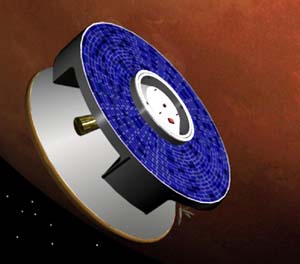 |
BAE RAD6000 w/ 64MB of Solid State Memory | The RAD 6000 is a radiation hardened IBM POWER CPU made by British Aerospace Electronics. The Pathfinder Lander was used to communicate with the Sojourner mini-rover |
| 1996 | Sojourner (on Mars) 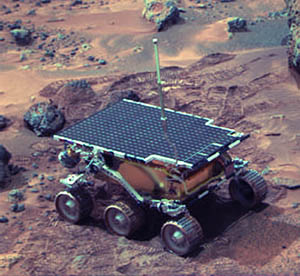 |
Intel 80C85 | All communications were handled through the Pathfinder Lander |
| 1996-2006 | Mars Global Surveyor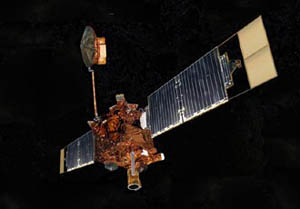 |
.An 8086 processor is used for the payload data subsystem, and 1750A processors for the standard controls processor and the engineering data formatter. Data is stored on four 0.75 Gb solid state recorders. | Mars Global Surveyor was the first US mission to Mars in 10 years and began the research needed to eventually send and land the Curiosity rover on the surface of Mars. Here we see 2 completely different types of processors used on a single spacecraft, which is actually fairly common, use the best part for whatever sub-system you are working on. |
| 1998 | International Space Station  |
Intel 80386SX-20 w/ Intel 80387 | There are several computers on the ISS. The most important are the command computers which use the i386. |
| 2004 | Spirit and Opportunity Rovers  |
BAE RAD6000 (25MHz Max): This is a radiation hardened version of the IBM RS/6000 Processor (RSC). Cost is around $200,000-$300,000 | The RAD6000 is becoming very popular for space applications that do not need large processing capabilities. There are over 200 RAD6000 processors currently in use by spacecraft. Higher end designs have transitioned to a RAD750 or Mongoose processor As of August 2012, The Opportunity Rover is still functioning and performing science. (Spirit cease functioning in 2011). Design life was only 3 months so both rovers well exceeded that. |
| 2007 | DAWN (Asteroid Rendezvous)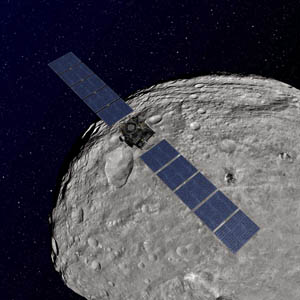 |
RAD6000 w/ 8GB of Solid State | DAWN is a solar powered spacecraft using Ion engines. It is designed to explore the asteroid Vesta and dwarf planet Ceres |
| 2011 | Curiosity 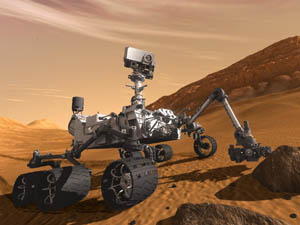 |
Dual BAE RAD750 @ 400MIPS (up to 200MHz): Radiation Hardened version of the IBM PowerPC 750 (one configured as a backup, that can take over if the other fails (or a software update disables it). The processor is designed to have no more then one single event upset (a problem requiring intervention from Earth) in its 15 year lifespan. | The Rover Compute Element also includes 256KB of EEPROM (likely for boot config etc) 256MB of DRAM and 2GB of Solid State Memory (Flash). The cameras also have their own Flash memory storage (8GB each for the mast cams). Each RAD750 board cost around $200,000 |
| 2012 | Morpheus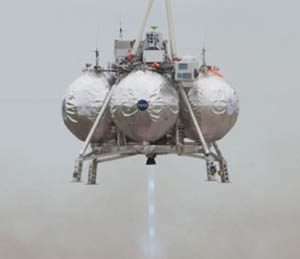 |
RAD750 Processor | The Morpheus Lander Concept used Natural Gas as a propellent. Unfortunately it burned and exploded during testing in August 2012. Undoubtably the RAD750 was destroyed |
| 2006-2026 | New Horizons (Pluto)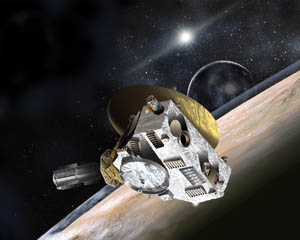 |
Mongoose-V: The Mongoose-V is a radiation hardened and enhanced version of the venerable MIPS R3000 processor running at 15MHz made by Synova. As of August 2012 Mongoose-V processors are $20,000-$40,000 | New Horizons also includes redundant 8GB banks of Flash Memory. It must store data for long periods as the data rate from the probe is so slow it will be well past Pluto before it can transfer all its data back to earth. It also will almost certainly have to be oriented such that its antenna are not pointing at Earth while conducting its observations of Pluto and other Kuiper Belt Objects. |
Other chips are as follows in lesser known space craft:
| Flight Processor Usage |
|
| Mission |
Processor |
| Cassini |
1750A |
| Cluster (ESA) |
1750A |
| MSTI-1,2 |
1750A |
| Rosetta (ESA) |
1750A |
| EOS Terra |
1750A (2) |
| EOS Aqua |
1750A (4) & 8051 (2) |
| EOS Aura |
1750A (4) & 8051 (2) |
| Clementine |
1750A, 32 bit RISC |
| MSTI-3 |
1750A, R-3000 |
| Pluto Express |
32 bit RISC |
| Sampex |
80386, 80387 |
| SMEX |
80386, 80387 |
| SWAS |
80386, 80387 |
| TRACE |
80386, 80387 |
| WIRE |
80386, 80387 |
| FUSE |
80386, 80387, 68000 |
| Surrey MicroSat |
80386EX (2) |
| UoSat-12 |
80386EX (3) |
| FAST |
8085 (2) |
| HealthSat-II |
80c186 (2), 80c188 |
| PoSat-1 |
80c186, TMS320C25, TMS320C30 |
| Galileo AACS |
ATAC (bit slice) and 1802 |
| SPOT-4 |
F9450 |
| EO-1/WARP |
Mongoose V |
| IceSat Glas |
Mongoose V |
| MAP |
Mongoose V, UTMC 69R000 |
| CGRO |
NSSC-1 |
| Topex/Poseidon |
NSSC-1 |
| UARS |
NSSC-1 |
| EUVE |
NSSC-1, 1750A |
| HST |
NSSC-1/386, DF-224->486 |
| Coriolis |
RAD6000 |
| Deep Space-1 |
RAD6000 |
| Gravity Probe B |
RAD6000 |
| HESSI |
RAD6000 |
| MARS 98 |
RAD6000 |
| SIRTF |
RAD6000 |
| SMEX-Lite |
RAD6000 |
| Swift |
RAD6000 |
| Triana |
RAD6000 |
| MightySat-II |
TMS320C40 (4) |
Notes:
Mongoose V is a MIPS R3000 core
TMS320 is a DSP chip
1750 is a MIL-STD 16 bit non-RISC CPU.
NSSC-1: NASA Standard Spacecraft Computer
F9450: 1750A MMU
As you can see a WIDE variety of chips are used in space. Today most are progressing towards 32-bit CPUs with memory management. This is so that programming is easier and a wider spread of operating systems/applications (Java, Linux, VxWorks etc) are available to use.